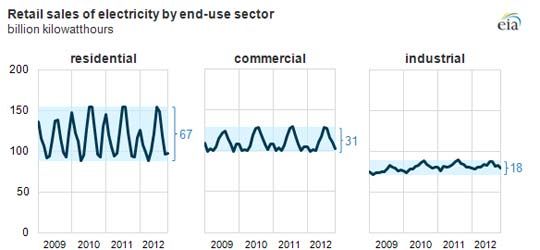When it comes to electricity hogs, the perpetrators are close to home and not at industrial sites and businesses. Sure, the factory on the other side of town uses far more electricity overall than an individual house, but in aggregate, single-family homes see far greater seasonal variation throughout the year -- with higher peaks and lower valleys than any other sector.
Recent data form the U.S. Energy Information Administration illustrates the significant spikes homes go through in summer and winter. Electricity is most in demand in summer to power air conditioning -- but some regions also have winter peaks, depending on the type of heating fuel used. Even if the heating fuel is gas or oil, fans and compressors in boilers and furnaces still need power.
The peaks in the residential sector can be as big as 67 billion kilowatt-hours, compared to only 18 billion kilowatt-hours for a summer peak in the industrial sector. Yet the vast majority of demand response programs target commercial and industrial customers, a far less fickle bunch than the average residential utility customer.

As utilities and grid operators look for more peak relief, many are casting a new light on residential customers -- and they should. Residential customers are the most expensive to serve, according to the EIA, because of their wild swings in electricity use, among other issues.
Oklahoma Gas & Electric is using 150,000 residential customers as a key part of its plan to delay new generation till at least 2020. Pepco and Comverge are hoping to get 300,000 customers into home demand-response programs.
Grid operators like ERCOT, PJM and MISO are increasingly looking for more demand response. The case for cutting peak in homes has changed in recent years, with more homeowners investing in two-way smart thermostats and software-as-a-service models that can deliver negawatts for less money than programs that require a lot of hardware.
Utilities that have invested in smart meters are looking for ways to leverage those networks for demand response, while other utilities and vendors are increasingly turning to broadband as a path into the home for load control. It’s still early days, but residential demand response is becoming not only more feasible, but more critical.



